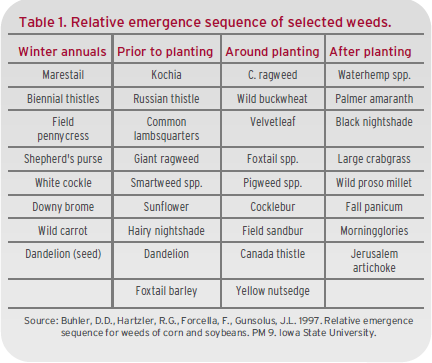What You’ll Learn...
- Weeds can reduce soybean yield by 1% per day if left uncontrolled after the V2 to V3 stage of soybean growth.2
- University research shows that weeds emerging with the crop should be removed by the V2 or V3 stage of soybean development, when weeds are less than 4 inches tall, to minimize yield loss due to weed competition.
- Using pre-emergence residual herbicides with a planned POST application is the best approach to avoid losses from early season weeds.
The Critical Period for Weed Control
Successful integrated weed management systems require an understanding of crop and weed interactions. Weeds impact soybean yield potential by competing for limited light, water, and nutrient resources. Weeds and soybean can coexist during the early season without compromising yield potential, but once plants begin to increase in size, competition for resources begins.
The critical period for weed control (CPWC) is the time interval where it is necessary to maintain weed-free conditions to prevent an unacceptable reduction in yield potential. The CPWC represents the critical timing of weed removal and the minimum weed-free period after planting. The CPWC is influenced by weed morphology, emergence timing and duration of emergence, weed density, environmental conditions, the competitive characteristics of the crop, and system management. The critical period can range from the V1 to V6 stage of soybean growth, depending on row spacing, production area, and environmental conditions.1
Weeds emerging with the crop can cause the greatest reduction in yield potential (Table 1). Broadleaf weeds such as giant ragweed, sunflower, and cocklebur are more competitive with soybean than grass weeds (Table 2). University research shows that weeds emerging with the crop should be removed by the V2 or V3 stage of soybean development, when weeds are less than 4 inches tall, to minimize yield loss. Weeds can reduce soybean yield by 1% per day if left uncontrolled after the V2 to V3 stage of soybean growth.2


Factors That Affect Competition
Management practices and environmental conditions affect crop and weed competition. Early planting is recognized as a good practice but it may increase the CPWC because significant weed emergence may occur after planting.1 However, very early planting, combined with reduced or no tillage, allows for greater weed competition, as well as for different species of weeds to be present. Weeds that are established at the time of crop emergence begin to compete with the crop earlier than weeds that emerge only after the crop emerges.3
Higher planting density and narrow row spacing can improve yield potential, crop competitiveness, and help reduce weed competition.4,5 Later maturity soybean products with high yield potential for a production area can reduce losses due to weeds, particularly in narrow row, high plant density systems.6
Predicting the precise time of the CPWC is difficult and misinterpretation can lead to delayed post-emergence (POST) herbicide applications.7 Using pre-emergence (PRE) residual herbicides plus a planned POST application is the best approach to avoid losses from early season weeds and help protect soybean yield potential.
PRE herbicides can provide control of resistant weeds and allow for more flexible POST application timing.8 Including soil residual herbicides in POST tank mixtures can help control late emerging weeds such as waterhemp or Palmer amaranth.
Weed competition with soybean can cause substantial reductions in yield potential (Table 3). Knowledge of the weed species in a field and the competitiveness, emergence pattern, and density of the weed community can be used to develop effective herbicide programs and other management practices to minimize yield potential losses, herbicide resistance, and contain aggressive weed species. Visit www.roundupreadyPLUS.com for solutions and recommendations.

Weeds that germinate and emerge with soybeans usually compete well with soybeans. Nearly complete weed control is needed during the first weeks after soybean emergence to avoid yield potential losses due to early emerging weeds. Soybeans are susceptible to shading by weeds and weeds compete with soybeans for nutrients and water. Soybeans are especially sensitive to moisture deficiencies in late summer and even a few large weeds left in the field can severely reduce yield potential.9
Sources:
1 Knezevic, S.Z., Evans, S.P., Blankenship, E.E., Van Acker, R.C., and Lindquist, J.L. 2002. Critical period for weed control : The concept and data analysis.
2 Hartzler, R. 2003. Is your weed management program reducing your economic return? Iowa State University.
3 Hager, A., and Wax, L. 1998. Weed/Crop competition: Factors to consider. The Bulletin. University of Illinois.
4 Harder, D.B., Sprague, C.L., and Renner, K.A. 2007. Effect of soybean row width and population on weeds, crop yield, and economic return. Weed Technology, 21(3):744-752.
5 Hock, S.M., Knezevic, S.Z., Martin, A.R., and Lindquist., J. L. 2006. Soybean row spacing and weed emergence time influence weed competitiveness and competitive indices. Weed Science, 54(1):38-46.
6 Nordby, D.E. Alderks, D.L., and Nafziger, E.D. 2007. Competitiveness with weeds of soybean cultivars with different maturity and canopy width characteristics. Weed Technology 2007 21:1082–1088.
7 Fickett, N.D., Boerboom, C.M., and Stoltenberg, D.E. 2013. Soybean yield loss potential associated with early-season weed competition across 64 site-years. Weed Science, 61(3):500-507.
8 Hartzler, R.G. 2006. Role of preemergence herbicides in Roundup Ready® crops. Part I and II. Iowa State University.
9 Gunzolus, J.L. Weed control in soybeans. University of Minnesota.
